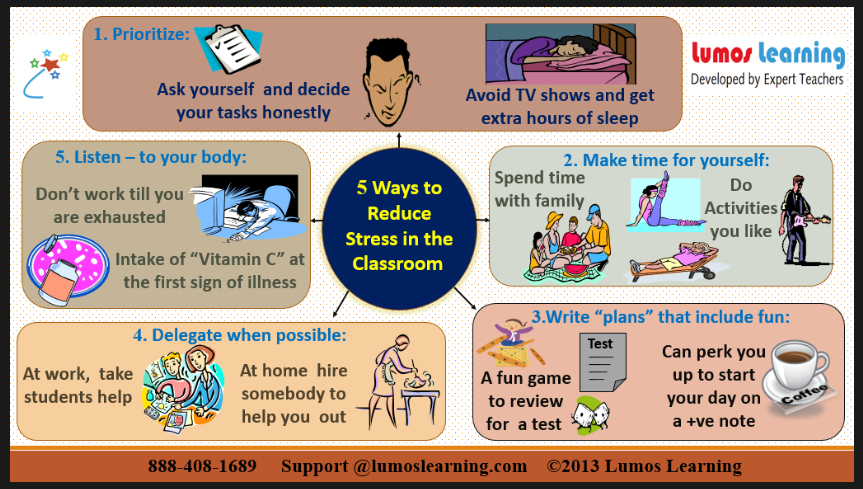
You’ve been in school for a few months now, and the work is beginning to pile up. Between lesson plans, grading, report cards, parent-teacher conferences, and your personal life, it’s easy to lose yourself in the never-ending “to do” list. But it doesn’t have to be that way. There are some easy actions you can take to ease your stress and busy schedule:
1. Prioritize:
To do this well, you’ll need to be honest and realistic with yourself. Look at your commitments and daily schedule. Decide which activities, committees, and tasks are non-negotiable, and then take a hard look at everything else. Ask yourself questions such as: do you really have to grade every homework assignment? Or can you spot check occasionally and still have a pulse on where your students are? At home, can you cut out a TV show or two to give yourself extra free time (or simply to have time to sleep?).
Decide what’s important to you and be sure that these activities are part of your “non-negotiable” list. Even though certain items may seem unimportant because they don’t warrant emergency status, if there’s an activity that reinforces your core values, it would be beneficial to make time for this – as opposed to using time for things that are less important to you. You may be devoting precious time to commitments that have become more of a habit than something that you really need (or want) to do. Maybe you’ve over committed yourself and need to say no to activities or organizations until you get your schedule back under control.
2. Make time for yourself:
No matter how busy your life is, carve out time for yourself…and then guard it ferociously! Treat this time as you would any important appointment, and be sure to use that time to nourish yourself with activities that you like. You might decide to work out, take a nap, play an instrument, discover a new hobby, read, take a class… basically, anything that you enjoy will work!
Be sure to choose an amount of time and frequency that is realistic. For instance, you may feel that fifteen minutes a day works well with your
schedule, while someone else may decide to designate one hour every three days. What matters most is that you are being good to yourself, because then when you go into the classroom or spend time with friends and family, you’re a more pleasant (and interesting!) person to be around who has more to give.
PARCC Test Practice: Online Resources for Educators
3. Write “plans” that include fun:
This could mean planning a fun game to review for a test that breaks up the normal daily routine, thus making class time novel and enjoyable for you and your students. Or, plan to do something fun right after work once or twice a week: having something to look forward to can make any day a good one, no matter how many curve balls are thrown your way.
Sometimes something as simple as ordering an exotic cup of coffee on your drive to school can perk you up and start your day off on a positive note. The more you look to infuse some fun in your day, the more you’ll enjoy yourself and find that irritating people and circumstances don’t bother you as much as they did before.
4. Delegate when possible:
This goes for home and school. If you find yourself spending hours on bulletin boards, consider asking helpful students to assist you: most kids
love the extra tasks and would jump at the chance to lend a helping hand. Or collaborate with colleagues and divvy up your workload. If you teach similar units, take turns making copies, creating tests and quizzes, etc. If two or three of you get together and divide the work, you’ll cut your prep time in half – or more.
At home, look at the things that take up time and decide if there’s someone (in your family or that you could hire) who could help out. Maybe hiring someone to clean once or twice a month is an option, and this alone could save you hours of time, freeing you up to do other jobs…or to relax for once! If you live with others, devise a plan to share the responsibilities at home. For example, a spouse or older child who can help with carpooling can be a lifesaver and stress reducer.
Sometimes people resist giving up control over certain chores, fearing it won’t be completed “correctly”. Think about it: would you rather have the ironing done “your way” or have some extra minutes because a generous family member is willing to pitch in and do it for you, even if it’s not
perfect”?
Recommended Read: WAYS TO REDUCE STANDARDIZED TESTING STRESS AND ANXIETY AND POSITION YOUR CHILD FOR SUCCESS BY JULIE C. LYONS
5. Listen – to your body:
You know the signs of an impending cold, don’t you? Unfortunately, many teachers feel they just “don’t have time” to get sick. Sadly, letting yourself get run down and exhausted simply means that you’re opening yourself up for illness. In that state, you’re operating on less energy. How can you expect to be your best – at school or at home – if you’ve lost your voice, everything aches, and all you want to do is put your head on the desk?
At the first sign of illness or fatigue do whatever it takes to incorporate healthy measures in your routine: go to bed a bit earlier, increase your intake of Vitamin C, etc. The more you can slow down until you build up your immunity, the less chance you have of becoming so ill that it stops you in your tracks. And if you are really sick, take the time you need to stay home and recover. You’ll bounce back more quickly, be less prone to picking up more germs at school, and you’ll keep your germs contained (instead of spreading it on to your students).
Being a teacher isn’t an easy task, but with some forethought and resolve, you can reduce your stress levels and make your days more healthy, fulfilling, and fun.
Which ideas have worked for you?
Let us know how you reduce stress in the classroom and at home!



Very nice write-up. I absolutely love this website. Keep writing!
Do you mind if I quote a few of your articles as long as I provide credit and sources back to your webpage? My website is in the very same area of interest as yours and my visitors would certainly benefit from a lot of the information you present here. Please let me know if this ok with you. Thank you!
I want to to thank you for this excellent read!! I absolutely loved every little bit of it. I’ve got you saved as a favorite to check out new things you post…
Hey! I stumbled your blog on Facebook. I am posting here to know what theme you are using on this website, I would love to use the theme that you’re using so I can use it on my site.
Regards.
Pingback: Thinkeducative